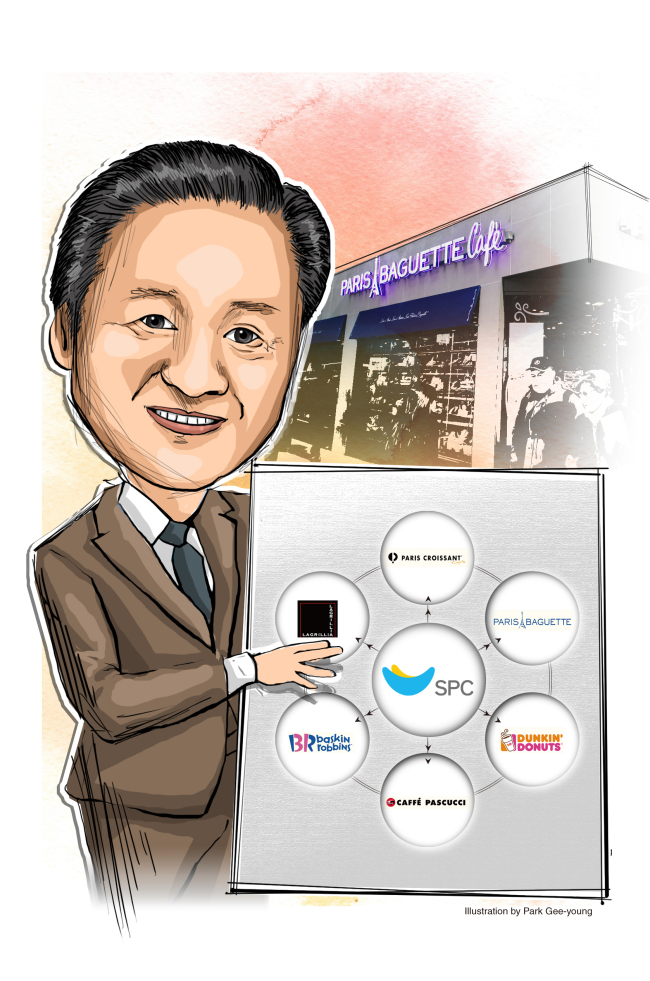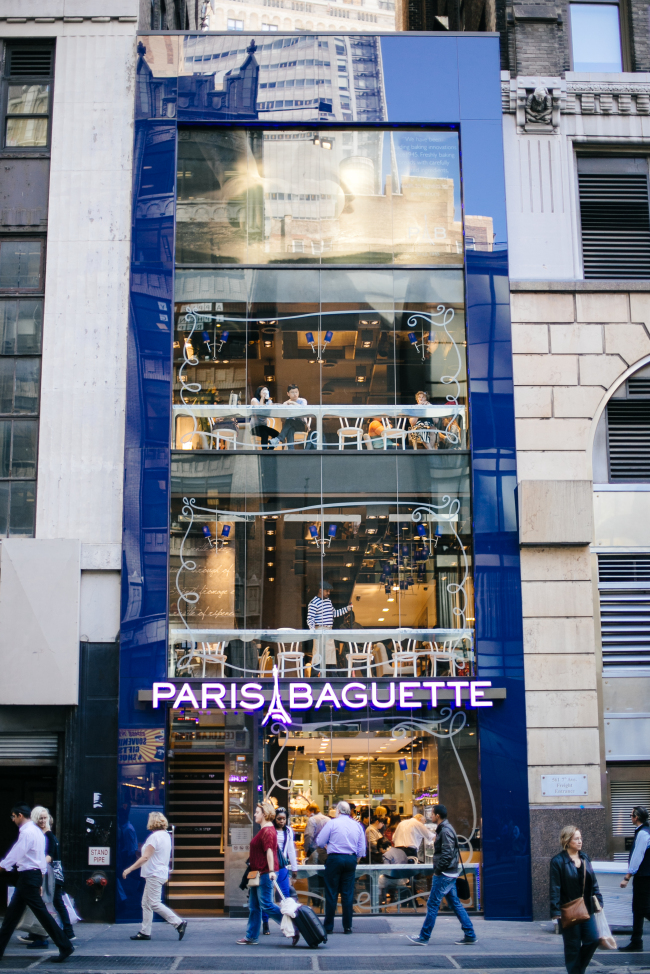[Power Korea] SPC Group bakes formula for success
Korea’s No. 1 confectionery brand engages in creative, innovative strategies to entice global audience
By Korea HeraldPublished : Nov. 28, 2013 - 19:54

The Korea Herald is publishing a series of articles titled Global Brand as part of the first installment of Power Korea. Korea’s success story is a 60-year-old tale written by not one, but many who worked to build one of the world’s most powerful nations from the ashes of war. This Global Brand series is designed to honor those who made this Korean Dream come true. This is the 18th part
of the Global Brand series. ― Ed.
“I’ll do my utmost to help Korea earn a reputation as ‘the mecca’ for bread and pastries.”
The acceptance speech chairman Hur Young-in of SPC Group ― the country’s leading confectionery brand ― gave when he received a prestigious management award last week reflected his dedication and passion to continue cultivating a brand he helped mold over decades.
In 1945, Hur’s father, the late Hur Chang-sung, set up a small confectionery outfit named Sangmidang, in hopes of turning it into a major corporation one day. Later on in 1959, the business started to take off and Sangmidang was changed to the name Samlip.
A couple of years later, Samlip began to produce bread and biscuits by the bulk. Lucky for Hur, his business was precisely aligned with the government policies at the time that were mapped out to help feed the public as the country struggled to rebuild itself in the aftermath of the Korean War.
Soon enough, it was churning out nationwide hits, including a cream-filled pastry that was the first of its kind to hit the shelves in Korea. Samlip’s quality was high enough to qualify for sales in the U.S. military camps stationed here.
Competition inevitably emerged. In the late 1960s, a number of rivals including Koryo Dang Bakery, Tae Geuk Dang and New York Bakery hit the scene.
But the elder Hur had a strategy: In 1972, he set up another arm called Shany to specialize in high-end cakes. Three years later in 1975, Samlip went public, a move that reflected its growing breadth.
From then on, the company accordingly weathered much turbulence amid rivalry as well as the changing tastes and trends of the Korean public.
Shany braved on in the face of a myriad of challenges and was ultimately able to spawn a number of best-selling brands.
Eventually, the current SPC Group chairman, who had been overseeing Shany’s operation, took over Samlip Group.
SPC has now matured into Korea’s No. 1 confectionery firm, operating more than 20 brands that are not just limited to bread and pastries, but also beverages and even the restaurant business.
In terms of structure, SPC Group consists of three affiliates: Samlip, Paris Croissant and BR Korea.

Paris Croissant forms the crux, handling most of the trendier and best-selling brands such as Paris Baguette, Paris Croissant, La Grillia, Caffe Pascucci and Jamba Juice.
Samlip is mostly about maintaining the company’s legacy and is involved chiefly with traditional foods such as rice cakes and the beloved breads of the past. BR Korea consists of the ice cream brand Baskin Robbins and donut maker Dunkin’ Donuts.
This year, Samlip celebrated its 68th anniversary, for which the company announced a new company image and its vision for the year 2020.
“We plan on ramping up our investment to meet sales of over 4 trillion won by 2020,” said Yoon Seok-choon, the chief executive of Samlip.
Venturing overseas: U.S., China and Southeast Asia
In March last year, the number of Paris Baguette outlets abroad passed the 100 mark. The new milestone for the Seoul-based bakery chain came less than a decade since its first overseas store opened in Shanghai in 2004.
And with the 100th opening, SPC Group set a new ambitious goal of nurturing Paris Baguette to become the No. 1 bakery chain globally by 2020.
Under the new plan, the number of chain stores will surge to 3,000 in 60 countries, while its overseas sales will reach 2 trillion won. As of November, Paris Baguette owns 171 outlets in China, the United States, Vietnam and Singapore.
“Over the past decade, we have placed top priority on brand awareness and product quality,” said Jang Seung-hoon, a spokesman for SPC Group. “In order to achieve the renewed goal, we will ramp up localization efforts in more aggressive ways.”
Among SPC’s forays into markets abroad, the U.S. is one of the most crucial given the group’s goal to create the high-end image.
The first SPC outlet in the U.S. opened in 2005, in the Koreatown area of Los Angeles. Since then, the number of stores has surpassed 30 across the U.S., with some seeing up to 1,000 customers a day.
Notably, the Palisades location in New Jersey opened in 2007 as the first Korean bakery to set up shop on the U.S. East Coast.
This year, SPC hit yet another milestone when it opened a store on Broadway near New York City’s Times Square in October. Just a month later, the company opened additional shops in Midtown and the Upper West Side.
SPC faces competition with brands including Au Bon Pain, Panera Bread and Pret a Manger, the Korean firm said.
The decision to set foot into New York City reflects a change from the earlier days when SPC’s stores had been limited to areas with a heavy Korean-American population.
It shows that SPC is confident enough to go wherever it feels there is the demand for high-quality bread and pastries.
According to the company, about 60-70 percent of customers visiting its 30 U.S. stores have no Korean background.
“We felt we needed to make it where we wouldn’t have been able to enlist the support from fellow Koreans,” said Jang.
Efforts to better serve the local palate have also proven to be successful in China, another vast market for SPC.
Despite its huge potential, China is a tricky market for global brands to succeed in ― especially in the bakery sector, where even renowned French bakeries like Paul and Fauchon have retreated after failing to satisfy the local palate.
That’s why Paris Baguette put considerable resources into market research, sending company officials to study food culture and business environment there since the mid-1990s.
Even after its official launch in 2004, the company carried out aggressive marketing activities. They also mingled with local customers by holding bakery classes and sponsoring important sporting events.
The company opened its first stores in affluent residential or shopping districts targeting high-income households. And the newly premium image helped to raise brand awareness overall.
Currently, Paris Baguette operates 124 stores across China. Now a growing number of Chinese bakery students and industry officials are choosing to study in Korea instead of previously popular destinations such as Europe and Japan.
Southeast Asia, especially Vietnam and Singapore, has a lot of growth potential as customers there are younger and more open to Korean culture.
Vietnam is an emerging market for the retail and food sectors, with 60 percent of the population younger than 30. Due to its French influence, the country has a well-established caf and bakery culture as well.
Further, Paris Baguette boasts a variety of 150 different bakery items, more than triple those of other bakery chains, while its hip interior design also appeals to younger generations.
The bakery chain plans to use the Singaporean market as its Southeastern business hub, taking advantage of geographic benefits that connect neighboring Asian countries.
In the highly competitive market crowded by Singapore’s own Break Talk and Yakun Kaya Toast as well as other global makers, the company aims to open 50 stores there by 2020.
By Kim Ji-hyun and Lee Ji-yoon
(jemmie@heraldcorp.com)
(jylee@heraldcorp.com)
-
Articles by Korea Herald









![[Kim Seong-kon] Democracy and the future of South Korea](http://res.heraldm.com/phpwas/restmb_idxmake.php?idx=644&simg=/content/image/2024/04/16/20240416050802_0.jpg&u=)








![[KH Explains] Hyundai's full hybrid edge to pay off amid slow transition to pure EVs](http://res.heraldm.com/phpwas/restmb_idxmake.php?idx=652&simg=/content/image/2024/04/18/20240418050645_0.jpg&u=20240418181020)

![[Today’s K-pop] Zico drops snippet of collaboration with Jennie](http://res.heraldm.com/phpwas/restmb_idxmake.php?idx=642&simg=/content/image/2024/04/18/20240418050702_0.jpg&u=)